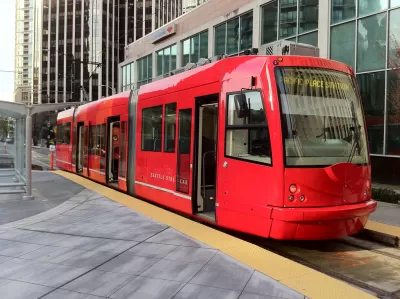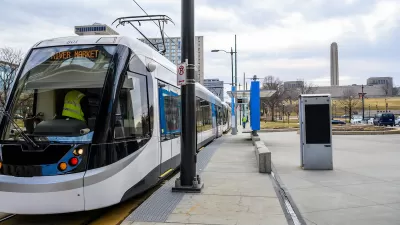While they're currently in vogue, streetcars are only worthwhile if they can be a viable option for local residents. Unfortunately, this is rarely how the systems are designed.

Streetcars, once a common feature in American cities, are on their way back. "The recent efforts of cities across the United States to build streetcar lines running through their downtowns have been heralded by some as an ideal amalgam—an investment in improved transportation that also leads to adjacent private development."
In a piece for Urban Land Magazine, Yonah Freemark criticizes existing streetcar systems for appealing to tourists rather than local residents. According to Freemark, there is no clear indication that installing sluggish streetcars actually drives economic growth.
From the article: "The focus on streetcars is reminiscent of the economic development strategies urban planners previously used in attempting to spruce up their downtowns, like pedestrian malls in the 1960s, festival marketplaces in the 1970s, and convention centers in the 1980s, none of which was particularly successful in reviving any downtown."
Freemark argues that a good streetcar system serves local needs, and does not serve as a downtown take on the Disneyland monorail. "The biggest problem is that they are typically too slow to be useful for most people [...] In the illustrative case of the recently opened Atlanta Streetcar, these conditions mean that the vehicles roll down the street at a measly six miles per hour (9.7 kmph). And that's once passengers have made it on board."
FULL STORY: Transportation First, then Economic Development for Streetcars

Alabama: Trump Terminates Settlements for Black Communities Harmed By Raw Sewage
Trump deemed the landmark civil rights agreement “illegal DEI and environmental justice policy.”

Study: Maui’s Plan to Convert Vacation Rentals to Long-Term Housing Could Cause Nearly $1 Billion Economic Loss
The plan would reduce visitor accommodation by 25% resulting in 1,900 jobs lost.

Planetizen Federal Action Tracker
A weekly monitor of how Trump’s orders and actions are impacting planners and planning in America.

DC Extends Application Window for Outdoor Dining Permits
District restaurants will have until the end of November to apply, but businesses with permits in rush hour parking lanes must end operations on July 31.

Wind Energy on the Rise Despite Federal Policy Reversal
The Trump administration is revoking federal support for renewable energy, but demand for new projects continues unabated.

Passengers Flock to Caltrain After Electrification
The new electric trains are running faster and more reliably, leading to strong ridership growth on the Bay Area rail system.
Urban Design for Planners 1: Software Tools
This six-course series explores essential urban design concepts using open source software and equips planners with the tools they need to participate fully in the urban design process.
Planning for Universal Design
Learn the tools for implementing Universal Design in planning regulations.
Caltrans
Smith Gee Studio
Institute for Housing and Urban Development Studies (IHS)
City of Grandview
Harvard GSD Executive Education
Toledo-Lucas County Plan Commissions
Salt Lake City
NYU Wagner Graduate School of Public Service




























